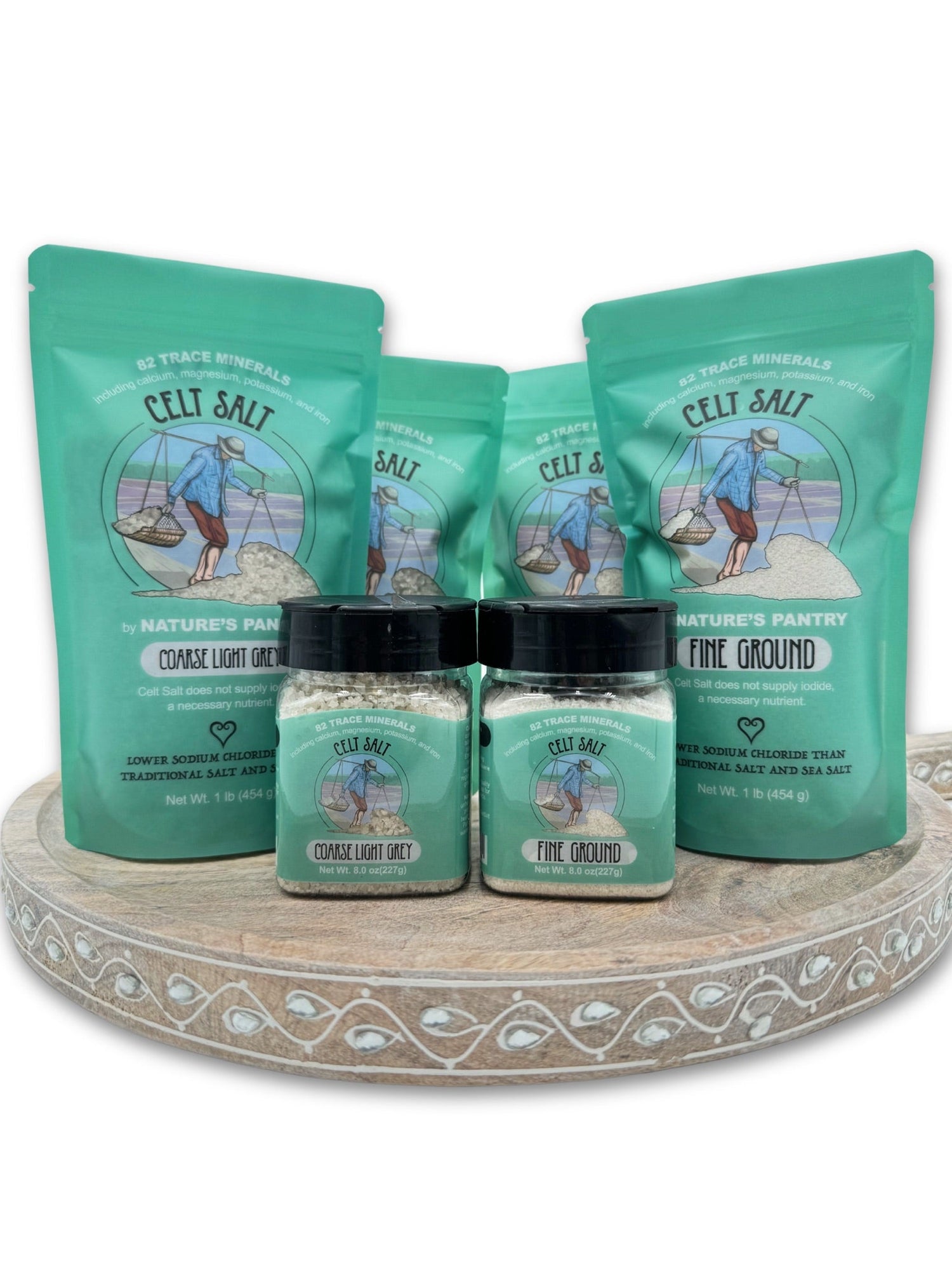FAQs
Who is Celt Salt & Nature's Pantry
Celt Salt is the first product from Nature’s Pantry, founded by Brian, a California-based father of four.
After years in the life insurance industry witnessing the effects of poor health — and going through his own 50 lb weight-loss transformation — Brian saw a need for clean, nutrient-rich pantry staples families can trust.
Celt Salt is built on faith, family values, and uncompromising quality. Our mission is simple: make it easy to choose better health, starting with the salt on your table.
What makes Celt Salt special?
Celt Salt is unrefined, mineral-rich sea salt traditionally harvested in France for nearly 2,000 years.
The Celts, who settled in the Guérande region, pioneered the clay-lined salt marsh method still used today. In France, it’s known as sel gris (“grey salt”).
We use the Coarse Grey variety — naturally infused with trace French green clay — making it perfect for everyday consumption. It’s lower in sodium, packed with 82 trace minerals, and free from additives or processing.
Where does it come from & how is it harvested?
- Origin: Brittany, France
- Method: Hand-harvested using traditional Celtic techniques
- Certifications: Non-GMO Verified, Kosher Certified, Paleo-friendly
Coarse Grey Celt Salt – Sun and wind dried, retaining ocean moisture (“mother liquor”) and a full spectrum of minerals.
Fine Ground Celt Salt – Low-temp dried and finely milled for even mixing in cooking and baking.
Why is Celt Salt considered nutritious?
We believe unrefined sea salt offers benefits due to its broad spectrum of trace minerals. It is additive free just the way nature intended. While we don’t make medical claims, many culinary and wellness experts appreciate its mineral profile.
Why is Coarse Grey Celt Salt moist?
The moisture you see is natural brine from the ocean. We never kiln-dry or over-process our salt, so it retains its mineral-rich character.
Does Celt Salt contain iodine?
No iodine is not added. Celt Salt naturally contains a variety of minerals but does not supply iodine, an essential nutrient.
Does Celt Salt expire?
No. Salt is Nature’s original preservative and will last indefinitely when stored properly.
Can I use Celt Salt in everyday recipes?
Absolutely! Use it 1:1 in place of regular salt for cooking, seasoning, or baking.
- For baking, choose Fine Ground Celt Salt for even flavor distribution.
- For Grilling Meats and Proteins Coarse Grey gives that needed enhanced flavor.
- Remember: you can always add more salt, but you can’t take it away.
Can Celt Salt be used beyond cooking?
Absolutely! It’s versatile—perfect for bath soaks, body scrubs, food preservation, and even nasal rinses, owing to its natural mineral composition and gentle texture.
Does Celt Salt contain lead?
Celt Salt is a natural, unrefined sea salt harvested directly from the ocean, which means it contains naturally occurring trace minerals - and like all sea salts, that includes very small, levels of certain elements such as lead.
Independent lab testing shows our lead content is around 0.4 mg/kg (ppm) - far below internationally recognized safety limits set by agencies like the FDA and European Union. The FDA does not have a specific legal limit for lead in salt. However, for general food safety, the broad recommendation for lead content in foods and supplements is to remain under 10 ppm (parts per million). These trace amounts are naturally occurring, not added, and are found in many whole, earth-derived foods.
We are committed to third-party testing and full transparency so you can season your food with confidence.
How much lead exposure do I get from using Celt Salt?
If you consume about 1.5 grams (1/4 teaspoon) of Celt Salt daily, your monthly lead exposure would be approximately 18 micrograms (0.018 mg).
To put this into perspective:
- This equals roughly 0.6 micrograms per day, which is well below the FDA’s older daily guideline of under 12.5 micrograms for adults.
- It’s also lower than European safety benchmarks based on body weight.
- While no level of lead is completely risk-free, the amount from Celt Salt is very low when used as part of a balanced diet.
- Keep in mind that total lead exposure includes other sources like food and the environment, but the lead from Celt Salt is minimal and within safe limits. (under 10mg
We perform third-party testing and uphold strict quality standards to ensure your health and peace of mind.
How does Celt Salt differ from regular table salt?
Celt Salt is unrefined, retains trace minerals, and is harvested traditionally—unlike processed table salt, which often includes additives and iodine. It has a more complex, nuanced flavor and coarser texture.
How does Celt Salt differ from Pink Himalayan salt?
While both are unrefined, mineral-rich salts, they come from very different origins. Celtic Salt is harvested from the coastal salt flats of Brittany, France, using ancient Celtic methods that preserve natural ocean minerals and moisture. It has a soft, briny flavor and a slightly moist texture. Not overpowering.
Pink Himalayan salt, on the other hand, is mined from ancient sea deposits in the Himalayan region of Pakistan. It has a drier texture, a distinct pink hue from iron oxide, and a milder, earthier taste.
In short—Celt Salt tastes of the sea, Himalayan tastes of the earth. Your choice comes down to flavor preference, texture, and intended use.
How should I store Celt Salt?
- In its factory packaging
- Dry location – Avoid humidity
- Airtight container – Glass or ceramic preferred
- No direct sunlight – Keeps flavor and quality intact
- Cool, stable temperature – Pantry or cupboard is ideal
Is Celt Salt non-GMO?
Yes. Salt contains no modified organisms, so it’s naturally 100% GMO-free.
Do you offer free shipping?
Yes — we offer free shipping on all orders over $20 within the continental USA.
